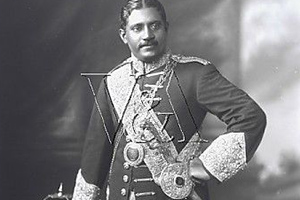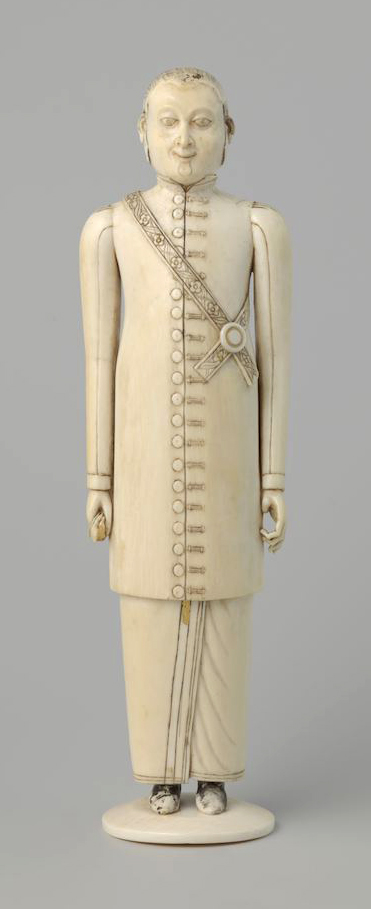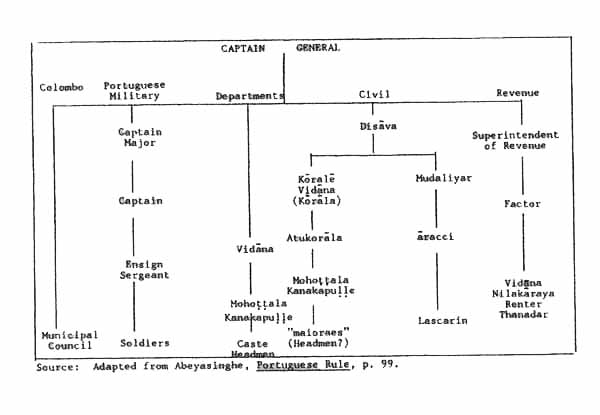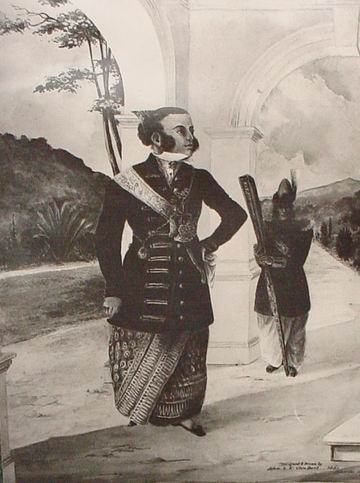
These pages examines the life and times of the Mudaliyars, their background, the social and administrative function performed by them, their status in society, duties, details that gives us a better understanding of our ancestors some of whom were Mudaliyars. The second page in this series gives the numbers and distribution, their salaries and allowances and the financial regulations which governed them, and some interesting insights into their lives.
Early nineteenth century sources unanimously agree that the highest status Singhalese in the low-country were those men known as Mudaliyars. However the administrative system they manned, known as the ‘Native Department’ in the British Administration, faded rapidly since its abolition in 1938. This page hopes to provide some background information on the Mudaliyars and other native headmen from the time of Manuel D’andrado in 1658 to the last of the De Fonseka Mudaliyars Henry Frederick de Fonseka in 1911.
 The functions of the mudaliyars varied over the various colonial eras. During the later periods their duties centered on the recruitment of labor under the Rajakariya system (compulsory service), revenue collection, and the maintenance of local control. They served in ranked competitive offices as interpreters, bookkeepers, translators, tax collectors, foremen, and advisors to the rulers on traditional law, scouts, messengers, and commanders of the local militia. However their origins goes somewhat past the colonial period, into the Kotte period.
The functions of the mudaliyars varied over the various colonial eras. During the later periods their duties centered on the recruitment of labor under the Rajakariya system (compulsory service), revenue collection, and the maintenance of local control. They served in ranked competitive offices as interpreters, bookkeepers, translators, tax collectors, foremen, and advisors to the rulers on traditional law, scouts, messengers, and commanders of the local militia. However their origins goes somewhat past the colonial period, into the Kotte period.
The term Mudaliyar is an old Dravidian word for a chieftain, derived from mutal, ‘first’. In Singhalese, Mudali Peruva refers to the ‘mudaliyar class’, and ‘mudiyanse’ refers to an individual mudaliyar. They have been assumed to be the creation of the colonial rule by many, and some even think of them as descended from the court nobility of Kotte. The truth lies somewhere between the two.
The kings who reigned at Kotte commonly mentioned mudaliyars as retainers at their courts, and the term appears in a fifteenth century slab near the bo-tree in Kalutara. The office of the mudaliyar was adopted along with other aspects of the Kotte administration by the Portuguese. Their colonial outposts were isolated and outnumbered. They subjugated the population with their military might. But to carry out their primary functions of commerce and conversion, they had to win the acceptance of the masses. One way they did this was to enlist the active loyalty of their local leaders. This account for the rapid rise in the status of the mudaliyar class, and the impression that they were a creation of the colonial rule.
Very little information is available of the mudaliyars in the years preceding direct colonial rule. The Portuguese seems to have adopted the Kotte system in essence, but replaced all the higher officials with Portuguese ones. This enhanced the importance of the Mudaliyars and Korala, who became the highest surviving indigenous officers. The Mudaliyars and Aracchi continued as commanders of the lascarins (militia), but were subordinate to the Disava, a Portuguese officer who assumed a Singhalese name. They created a new office called a Vidana, that were in charge of a korale. This separated the military aspect and the civil administration duties. The Dutch Governor Willem Flack joined the military and civil authority between the Mudaliyar and Korale into the person of the mudaliyar.


The Dutch drove out the Portuguese in the years 1638 – 1658, but stayed to rule a larger portion of the island. Unlike the earlier Portuguese the Dutch were concerned primarily with trade and commerce. It is in this connection that the Dutch found the Chief Headmen an indispensable body for the promotion of trade. The enlarged territories precluded the appointment of Dutch officials to every post. Thus they appointed natives of high standing to various posts. Our first recorded ancestors Louis D’andrado went on to become an Adigar at Kalutara, the highest post to be held by a native. Don Manuel D’andrado was appointed a Sabandaar in the court of Jaffna. Don Michael de Fonseka succeeded Don Louise as the Adigar of Kalutara. The Dutch also created the ‘Gate’ mudaliyars, those attached to the administration as interpreters and translators to the higher officials.
From what has been stated so far, it can be seen that the Chief Headman were a less favored section of the executive during Portuguese times. However during this period there has been a distinguished community in the field of war. Having been military officers already, their martial character and bearing, intimate knowledge of the country and influence over their feudal levies, rendered the chieftains powerful allies of the Portuguese Governors in their incursions and retaliatory wars with the Kandyan Kings. These Mudaliyars of the low country espoused the cause of the invaders, owing to community of interests and religious ties that developed with their arrival. Prominent amongst the Mudaliyars who loomed large in the pages of Portuguese History are Domingos Corea, Manuel D’Andrado and Don Cosmas, two of whom later went over to their own war weary countrymen. Corea however was re-captured and having recanted in penitence died the death of a traitor on the scaffold. (see The Chieftains of Ceylon – Reference Page). Manuel D’Andrado went on to fight against the Portuguese in the Dutch siege and capture of the fort of Jaffna.
From the days of the all powerful mudaliyars in the time of Manuel D’andrado, the powers declined gradually and in the later years with the granting of titular mudaliyar and muhandiram posts. Looking at our genealogy chart, we could see many Maha Vidane and Muhandirams up to the time of Johannes de Fonseka in 1819. Governor Brownrigg presented Johannes with a gold medal and the title on the 21st of November 1891. The home page displays a version of this, and S. R. de Fonseka’s page displays the photograph published in the book ‘20th Century Impressions.’
The families of the chiefs and some of the village headmen prospered from land grants and from favoritism in trade over their Singhalese competitors. The payment received by a mudaliyar was called an ‘accomodessan’ which consisted of a certain amount of land attached to each office in the mudaliyar system. Their profits were used in land investments which helped to raise the family wealth and status. Service tenure evolved in the seventeenth and eighteenth centuries as lifetime grants of land which eventually became heritable. Regular service was expected of the holder as a condition of tenure, and the land reverted to the government on the failure of male heirs of the non performance of duties. In certain cases it is said that these lands were illicitly appropriated as Paraveni land.
The Dress of the Karava Headmen in the early nineteenth century :
|
Rank |
Coat |
Trimmings |
Sword |
Belt |
| Mudaliyar | Silk or Cloth | Silver Buttons & Loops | Hilt and Scabbard of Silver and the Eyes and Tongue of the Lion’s Head of Gold | Gold or Silver Lace but not spangled |
| Muhandirams | Cloth or Linen | Silver Buttons & Loops | Hilt and Scabbard of Silver. In the middle of the Scabbard a plain plate of Tortoise Shell | Gold and Silver Lace |
| Arrachies | Cloth or Linen | Silver Buttons & Silk Loops | Hilt of Horn, embellished with Silver, with 3 Tortoise-shell plates | Colored Ribbon embroidered with Silk |
| Canganies | Cloth or Linen | Silver Buttons & Silk Loops | Hilt of Horn, embellished with Silver, the Scabbard of Horn or wood with 2 Silver Plates | Plain Colored Ribbon |
Source: Abraham de Seram, 1906 Reproduced from The Ceylon Almanac, 1811.
Glossary of Titles and Ranks :
|
Disave |
Governor of an administrative province. Always held by a colonial administrator (who took on a Singhalese title). |
| Adigar | Chief officer of State. The Adigar took precedence over all in the hierarchy of chiefs and was the highest post held by a native. |
| Korale; Coraal | A district; an administrative unit of a Disave; person in authority over a Korale (see map below) |
| Vidahn | Village level headman whose duties included keeping the peace. Maha (chief) Vidane, Vidane Aratchchi are titles conferred on a vidane |
| Mudaliyar | Chief headman; administrator of a Korale (military); used as a honorary title from the mid-nineteenth century. ( see separate story |
| Maha Mudaliyar | Chief Mudaliyar assisting the Governor as translator and interpreter. Largely ceremonial after 1833. |
| Mudaliyar of the Governors Gate | Mudaliyar who performs the functions of a Translator and Interpreter; Gate – Governors house; Highest Mudaliyar title. Titular |
| Muhandiram |
Title of rank; honorary title; assistant to a mudaliyar (military); honorary title conferred on native officials in the administrative hierarchy. Native Militiamen; eligible for military service under Rajakariya |
| Lascorins |
The term Lascorijn (Lascorins) is derived from the Persian word ‘Lashkari’ meaning one who serves in a laskar or camp. In some Dutch works the word ‘Lascar’ is used to indicate a sailor from the east. In Ceylon its original meaning of a soldier survives up to date. Lascorins were divided in to ‘ranchuwas’ (‘randje’), each consisting of two to three native headmen, Mohandiram, Arachchies or Kankanis and 24 rank and file. Several ‘ranchus’ were under the Mudaliyar of a Korale. Source: Catalogue of the Archives of the Dutch Central Government of Coastal Ceylon 1640 – 1796, M. W. Jurriaanse, 1943 |
| Sabandaar | Member of the Dutch Court; |
| Opperhoofd | (The provincial administrations of Galle and Jaffna was under a Commandeur. The other stations were placed under an Opperhoofd or President, usually with the rank of Onderkoopmen. The Governor was based in Colombo.) |
| Cochin | Indian port city in the Malabar coast, Kerala state. (click for map) |
| Korale | Map depicting the administrative districts, known as Korales |
The information on these pages have been taken from the Sessional Paper XXVII of 1935 ‘Report of the Commission on the Headmen System – November 1935‘. Extracts of the numbers and distribution of headmen, their salaries and allowances gives us a glimpse into their lifestyles of a bygone era, how much they earned and how the government of that day treated them. Also included are the financial regulations effective at that time. Among the special allowances given were reimbursements for employing watchers to look after dead bodies.
HEADMEN ( Mudaliyars )
The number and distribution of the headmen of various grades as at 1934 – 35 is shown below
|
Province |
District |
Chief Headmen |
Muhandirams |
Superior Headmen* |
Minor Headmen |
| Western | Colombo | 8 | 6 | 66 | 593 |
| Kalutara | 4 | 1 | 31 | 255 | |
| Central | Kandy | 8 | 37 | 461 | |
| Matale | 3 | 18 | 178 | ||
| Nuwara Eliya | 3 | 16 | 82 | ||
| Southern | Galle | 5 | 59 | 249 | |
| Hambantota | 3 | 1 | 30 | 145 | |
| Matara | 5 | 73 | 239 | ||
| Northern | Jaffna | 8 | 46 | 155 | |
| Mannar | 3 | 11 | 34 | ||
| Mullauitivu and Vavunia | 4 | 15 | 33 | ||
| Eastern | Batticaloa | 9 | 22 | 198 | |
| Trincomalee | 3 | 6 | 28 | ||
| North Western | Kurunegala | 6 | 55 | 483 | |
| Puttalam and Chilaw | 5 | 29 | 194 | ||
| North Central | Anuradhapura | 4 | 22 | 94 | |
| Uva | Badulla | 7 | 31 | 204 | |
| Sabaragamuwa | Ratnapura | 6 | 19 | 144 | |
| Kegalla | 4 | 24 | 190 | ||
| Total | 98 | 8 | 610 | 3959 |
Salaries:
In 1922, the salary of a chief headman was Rs. 1,200 per annum plus Rs.420 per annum temporary increase. The 1920 Headmen Commission left the question of the alteration of this salary to the Salaries Commission, which recommended that the chief headmen should be divided into three classes, to which the following salaries should be attached.
Class I Rs. 3,600 per annum
Class II Rs. 3,000 per annum
Class III Rs. 2,400 per annum
Promotion from one class to another to be dependent on satisfactory performance of duty, certified by the Government Agent. This scheme was adopted by the Government, and is still in force. It is necessary to remember that this salary scale is not intended to be commensurate with the value of the services rendered to the State by these officers. The Salaries Committee of 1926 describes their position as follows
“We cannot regard chief headmen as being in the same position as ordinary departmental officials, who are recruited without particular regard to their standing in the community. If we were to regard them as such, then we think a considerable improvement in their salary scale might be justified; but we would add that, if such an improvement were effected, then there would in our opinion be no ground for any limitation of the field of choice in the making of these appointments. Perhaps at some future date a service of Provincial Revenue Officials recruited by examination may replace the chief headmen, but as long as chief headmen are dignitaries as well as officials, as long as birth and the possession of landed property are regarded as almost essential qualifications to appointment, their scale of remuneration must be fixed with reference to these facts.”
The Headmen (Mudaliyars) were also entitled to the following Allowances.
Fixed Transport Allowance for Traveling inside the Division:
Prior to 1922, chief headmen received no allowance to cover the cost of traveling within their divisions, although their duties necessitated their keeping a conveyance. Attention. was drawn to this fact by the previous Headmen Commission and the proposal was accepted by the Government, and the motor car allowances of chief headmen were revised with effect from August 1, 1924, as follows.
For a motor car weighing more than 15 cwt. Rs 85
For a motor car weighing more than 10 cwt. and not more than 15 cwt. Rs 70
For a motor car weighing 10 cwt. or less Rs 60
These allowances were further reduced in 1930, and again in 1932. The rates fixed in 1932, which are still in force, are
For a private car weighing over 21 cwt. Rs 70
For a private car weighing over 16 cwt. but not over 21 cwt. Rs 60
For a private car weighing over 12 cwt. but not. over 16 cwt. Rs 50
For a private car weighing 12 cwt. or under Rs.40
The allowances originally granted for a horse (Rs. 85) and for a bullock cart (Rs. 40) have remained at those figures up to the present time.
Traveling outside the Division:
When traveling outside their divisions, chief headmen are governed by the ordinary financial regulations of the Government relating to the reimbursement of traveling expenses, with certain exceptions. The principal exception is that they are authorized to travel in their own conveyances, and to claim mileage at the prescribed rates, even along routes where public conveyances such as buses are available. They are also entitled to travel first class by train. Their rates of subsistence and lodging allowances are
Subsistence Lodging.
For those drawing Rs. 2,400 per annum 3 1
For those drawing Rs. 3,000 per annum 4 1
For those drawing Rs. 3,600 per annum 4 1
Allowance for Clerical Assistance.:
The Government considered the recommendations and decided that allowances for clerical assistance to chief headmen should be granted, to cover the cost of employing a clerk, or two clerks where two clerks were considered necessary for the transaction of purely Government business. The Government authorized the payment with effect from October 1,1928, of an allowance of Rs. 40 per month where one clerk is required, and Rs 70 per month where two clerks are required. These allowances are still in force.
Messenger Allowances.:
The 1926 Salaries Committee recommended that the salaries of chief headmen’s peons should not be separately itemised in the annual estimates, but that the chief headman should be paid an allowance to cover the cost of employing a peon or messenger. The Government accepted this recommendation. The number of peons allowed is one or two according to the necessities of the case. The rate of allowance per peon varies in different parts of the Island. The allowance is described in the Estimates as a “Messenger allowance the men employed are referred to as “messengers” or “peons”
BIBLIOGRAPHY:
- Peebles, Patrick. ‘Social Change in Nineteenth Century Ceylon’, Navrang, 1995.
- Roberts, Michael. ‘Caste Conflict and Elite Formation’, Navrang, 1982.
- Van Sanden, ‘The Chieftains of Ceylon’, 1936, Navrang 1994.
- Sessional Paper XXVII of 1935 ‘Report of the Commission on the Headmen System – November 1935’.